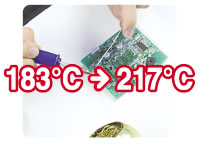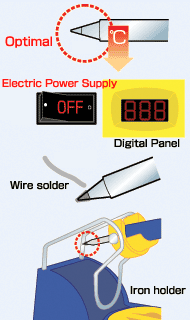| |||||||||||||
|
Point 1. Why do the tips of soldering irons oxidize easily when using lead-free solder? | |||||||||||||
| |||||||||||||
Point 2. How to Maintenance | |||||||||||||
| |||||||||||||
Point 3. Use the thermal recovery efficient soldering irons to increase the life span of the tips. | |||||||||||||
| Set the preset temperature as low as possible to slow the oxidization of the tips. (Never increase the temperature to more than what you need.) The melting point of lead-free solder is higher than that of eutectic solder. Setting the preset temperature with little regard for the characteristics of lead-free solder could raise the temperature of the tip and speed up oxidization. Here, we suppose that you are wondering how one can solder securely with high-melting-point lead-free solder without raising the temperature of the soldering iron. It’s the thermal recovery rate that answers your question. | |||||||||||||
| |||||||||||||
| Let us find the optimal temperature for the soldering iron using the formulas above when the melting point of solder is 180ºC. | |||||||||||||
| 180ºC + 50ºC = 230ºC 230ºC + 100ºC = 330ºC | |||||||||||||
| The optimal temperature for the soldering iron is 330ºC. | |||||||||||||
|
The melting point of lead-free solder is about 30ºC higher than that of eutectic solder. The melting point of lead-free solder, when using the formulas above, is about 360ºC. It is risky to use different types of soldering irons as often as the type of solder changes when soldering the same items. If the optimal temperature changes in a 30ºC range as often as the type of soldering iron changes, heat-sensitive parts will be negatively affected from the temperature changes. Consequently, both the thermal recovery efficient soldering irons and the thermal manageable soldering irons are required to keep the optimal temperature for the soldering iron for lead-free solder at the same temperature as that of the soldering iron for eutectic solder. | |||||||||||||
| When using the thermal recovery efficient soldering irons, the formula above (2) will be: The optimal temperature for the tip + about 60 to 70°C = the optimal temperature for the soldering iron The formula above cancels the increased temperature of the melting point of lead-free solder. In this way, the optimal temperature when using lead-free solder can be reduced to a temperature almost as low as the temperature needed for eutectic solder. One of the soldering irons for lead-free solder that we would like to recommend, which meet the requirements above, is the HAKKO FX-951, FM series. Especially, we would like to recommend the HAKKO FX-951 and HAKKO FX-952 that accept the T12 series, which has 84 variations of standard tips. For detailed information, click the URLs below. | |||||||||||||








